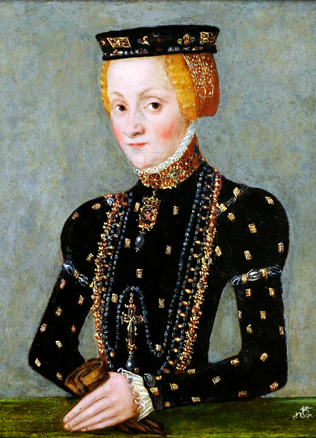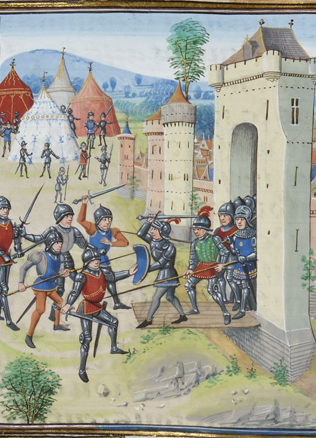In the shade of the Ruler: the early magnates and their symbols
At the date of 1360, the chronicler of the Teutonic Order Hermann von Wartberge described the expedition of the Crusaders to the homestead of the Lithuanian noblemen Eigintas who they called satrapas (the authors of the Order used this term to define the representatives of the Grand Duke of the highest rank). According to the chronicler, Eigintas boasted that he “could drive away all the Christians and the Germans out of Livonia and appoint his relatives and friends to their castles.” The Lithuanian nobleman thought in the categories of power and intended to send his people to the territories that would be conquered. He did not mention the prerogatives of the Grand Duke, which he naturally could not circumvent. But the ruler was far away and represented only the highest (and sometimes nearly abstract) level of power. In the social reality, the power of the ruler and the noblemen existed side by side. The passage of another chronicler of the Order Wigand von Marburg allows us to feel aristocratic self-awareness being formed by that power. In 1364, the Elder of the border castle of Veliuona and the ancestor of the famous Goštautas magnate family, when yielding himself prisoner of the Order, appealed to the Marshal of the Order asking the latter to take him into captivity honourably, as it was fitting. The marshal did as he was asked to and sent him to his tent. We witness an episode of communication between the noblemen from two different societies, which is based on a mutual respect and recognition. The behaviour of Goštautas reflects the understanding of magnate descent and the perception of one’s exceptional position – this is a prototype of that self-awareness of the nobility, which we find in more abundant sources of the 15th and the 16th centuries.
The myth of ducal autocracy
However, historiography claims that prior to baptism of Lithuania and the union with Poland the influence of the Lithuanian magnates was dependent on the favours of the Grand Duke. From the 15th century the almost absolute power of the ruler gradually started to decline in favour of the nobility. The metaphor saying that “ducal Lithuania” of the 15th century turned into “Lithuania of Lords” expresses this theory best. The turning point is dated to the times of Vytautas (1392–1430), when this Grand Duke supposedly started to promote the noblemen who were loyal to him, and whose position was strengthened even more by heraldic fraternisation with the Poles during the time of the Union of Horodło in 1413 and the adoption of the privileges of the Polish noblemen. These privileges granted the top of the nobility, and later its political institution as well – the Council of Lords – the right to deal with the most important affairs of the country, and the ruling dynasty lost a large part of its former competence.
However, this contraposition of the Grand Duke and the nobility is not adequate to the political and social reality of that time. Judging from everything, the reforms in the structures of power were initiated and implemented by the ruling dynasty of the Gediminids together with the most prominent magnate representatives.
Grand Dukes did not consider magnates to be their rivals because the latter did not make claims to the highest power and were content with their usual authoritative position in the Ruler’s surroundings and local societies.
Conflicts between separate groups of the rulers and the nobility were determined by the implicit or real violations of the hierarchial order and political rules rather than by a competition of power.
Do You Know?
The system based on the political consensus between the ruler and the magnates was a logical phenomenon in society in which power functioned on the basis of personal relations. The dukes, being unable to support themselves with the structures of the state, which were not formed yet, unavoidably had to seek support among the local nobility. Only he who had a strong background could rule. In the presence of constant fights for the throne, the possibilities of one or another candidate depended on the sympathies of the magnates, which they had both to win and to preserve. Therefore, the theory “a strong duke” – weak magnates” is contradictory and cannot explain the mechanism of implementing power.
Changes in self-awareness of the magnates
The first to formulate the theory of unrestricted power of the Grand Duke in Lithuania prior to the union with Poland was the famous Polish Chronicler Jan Długosz as far back as the second half of the 15th century. When speaking about the above-mentioned 1413 Union of Horodło and the privilege to the noblemen of Lithuania he stated that before the union and the baptism the noble rights were unknown in Lithuania, and he characterised the position of the Lithuanian noblemen as supposedly deprived of any rights and almost slavish. This biased attitude of the Polish chronicler affected significantly further historiography, which created the theory about the noblemen promoted by Władysław II Jagiełło and Vytautas.
The data of the sources contradict to the theory o f promoting “the new magnates”. It can be proved that all most important noblemen of the time of the rule of Vytautas came from the noble families therefore their appearance in the ruling elite was determined by anything but the ruler’s favour alone. True, changes in the internal structure of the Lithuanian magnates started in the times of Vytautas. One of the signs of these changes is the formation of the inherited names of the magnates, which changed the whole monomial index of proper names that existed until that time. In the pre-Christian period the Lithuanians had only one name, which was not usually inherited from generation to generation. It is only from accidental hints in the sources that we know that nobleman Buškys who lived in the times of Algirdas and Kęstutis was the father of Valmantas and the latter was the father of nobleman Kęsgaila from the times of Vytautas. The historians are apt to think that the inherited names of Goštautas, Radziwiłł, Astikas, Manvydas, Kęsgaila that appeared at the time of the rule of Vytautas show the creation of the new nobility. However, actually the appearance of these inherited family names reflected the changing understanding of the magnate family in which genealogical self-awareness and the name of the family handed over through the male line became most important. Consolidated, clearly defined and genealogically (i.e., as a succession of people going from one generation to another) perceived families substituted the “clan type” families that were widespread in the early monarchy.
Do You Know?
These families acquired not only an inherited name but also the symbols – coats-of-arms. The symbol of a Lithuanian nobleman is found for the first time in the 1380 Treaty of Dovydiškės between Jagiełło and the Teutonic Order to which nobleman Vaidila who was close to Jagiełło put his seal too. In the times of Vytautas’ rule, the most influential noblemen in his surroundings Albertas Manvydas, Stanislovas Čupurna, and Jonas Sungaila had coats-of-arms of the stylistics of the European knights. In 1413, they accepted Polish coats-of-arms in Horodle, which, from then on, together with the inherited name, symbolised the exceptionality of the family.
Rimvydas Petrauskas



